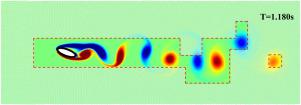Computer Methods in Applied Mechanics and Engineering ( IF 7.2 ) Pub Date : 2022-07-20 , DOI: 10.1016/j.cma.2022.115356 Tianrun Gao , Huihe Qiu , Lin Fu

|
The multi-resolution method, e.g., the Adaptive Particle Refinement (APR) method, has been developed to increase the local particle resolution and therefore the solution quality within a pre-defined refinement zone instead of using a globally uniform resolution for Smoothed Particle Hydrodynamics (SPH). However, sometimes, the targeted zone of interest can be varying, and the corresponding topology is very complex, thus the conventional APR method is not able to track these characteristics adaptively. In this study, a novel Block-based Adaptive Particle Refinement (BAPR) method is developed, which is able to provide the necessary local refinement flexibly for any targeted characteristic, and track it adaptively. In BAPR, the so-called activation status of the block array defines the refinement regions, where the transition and activated zones are determined accordingly. A regularization method for the generated particles in the newly activated blocks is developed to render an isotropic distribution of these new particles. The proposed method has been deployed for simulating Fluid–Structure Interaction (FSI) problems. A set of 2D FSI cases have been simulated with the proposed BAPR method, and the performance of the BAPR method is quantified and validated comprehensively. In a word, the BAPR method is viable and potential for complex multi-resolution FSI simulations by tracking any targeted characteristic of interest.
中文翻译:

流固耦合问题的基于块的自适应粒子细化 SPH 方法
已经开发了多分辨率方法,例如自适应粒子细化(APR)方法,以提高局部粒子分辨率,从而提高预定义细化区域内的解决方案质量,而不是使用平滑粒子流体动力学的全局统一分辨率( SPH)。然而,有时目标感兴趣区域可能会发生变化,对应的拓扑结构非常复杂,因此传统的 APR 方法无法自适应地跟踪这些特征。在这项研究中,开发了一种新的基于块的自适应粒子细化(BAPR)方法,该方法能够为任何目标特征灵活地提供必要的局部细化,并自适应地跟踪它。在 BAPR 中,块数组的所谓激活状态定义了细化区域,相应地确定过渡区和激活区。开发了新激活块中生成粒子的正则化方法,以呈现这些新粒子的各向同性分布。所提出的方法已被用于模拟流固耦合 (FSI) 问题。用所提出的 BAPR 方法模拟了一组 2D FSI 案例,并对 BAPR 方法的性能进行了全面量化和验证。总之,通过跟踪任何感兴趣的目标特征,BAPR 方法是可行的,并且有可能用于复杂的多分辨率 FSI 模拟。所提出的方法已被用于模拟流固耦合 (FSI) 问题。用所提出的 BAPR 方法模拟了一组 2D FSI 案例,并对 BAPR 方法的性能进行了全面量化和验证。总之,通过跟踪任何感兴趣的目标特征,BAPR 方法是可行的,并且有可能用于复杂的多分辨率 FSI 模拟。所提出的方法已被用于模拟流固耦合 (FSI) 问题。用所提出的 BAPR 方法模拟了一组 2D FSI 案例,并对 BAPR 方法的性能进行了全面量化和验证。总之,通过跟踪任何感兴趣的目标特征,BAPR 方法是可行的,并且有可能用于复杂的多分辨率 FSI 模拟。


























 京公网安备 11010802027423号
京公网安备 11010802027423号